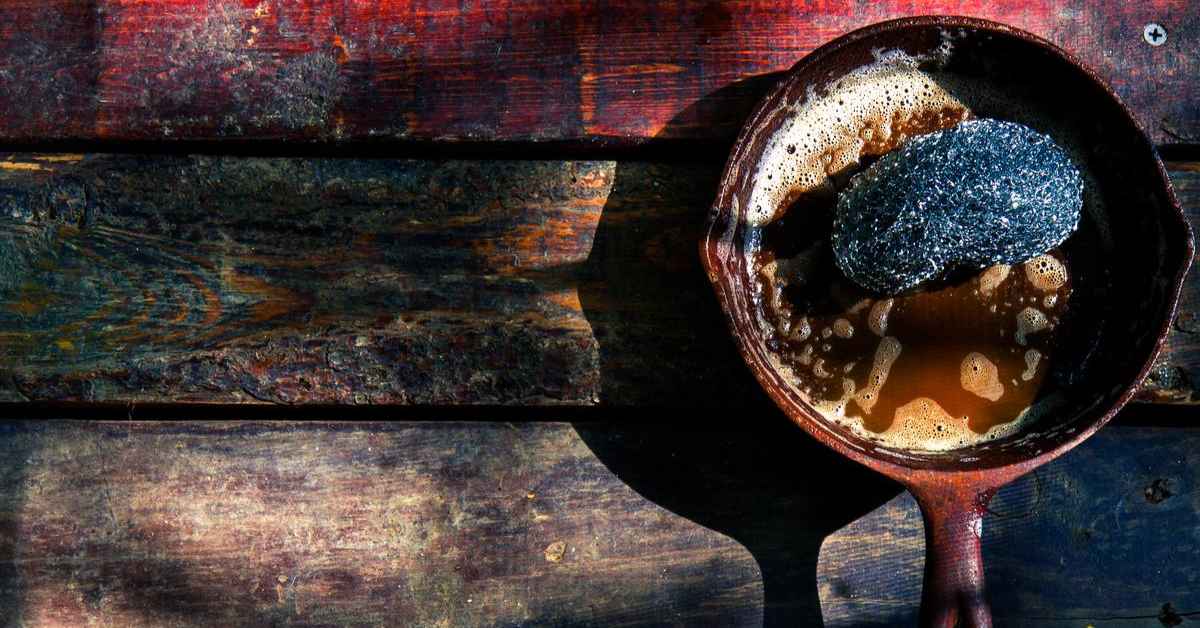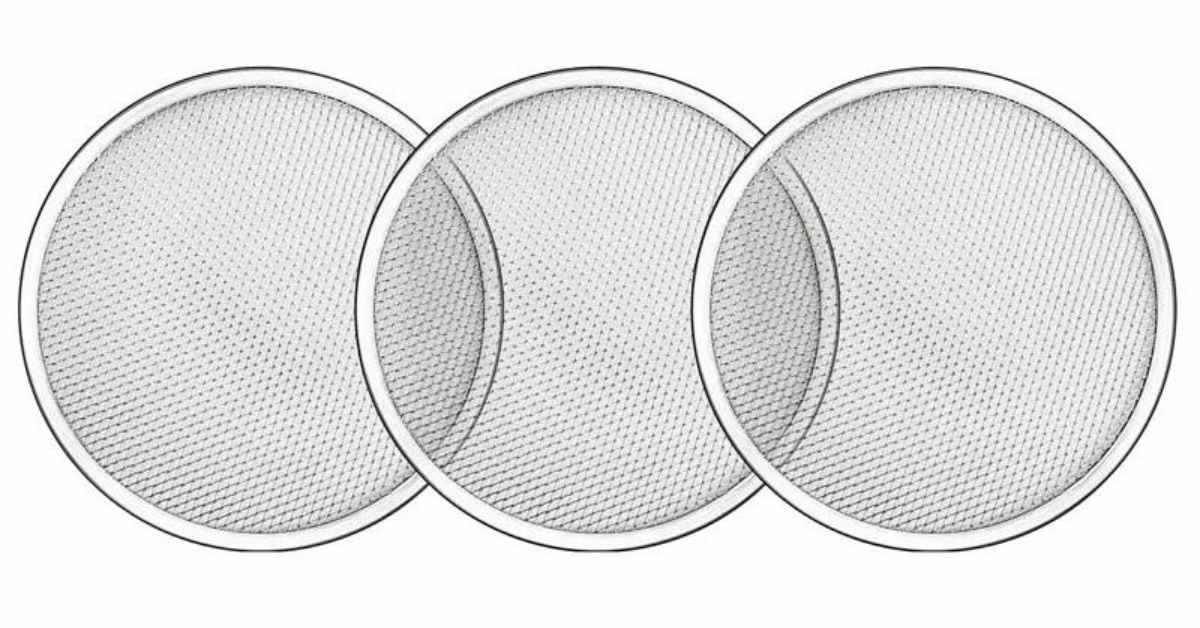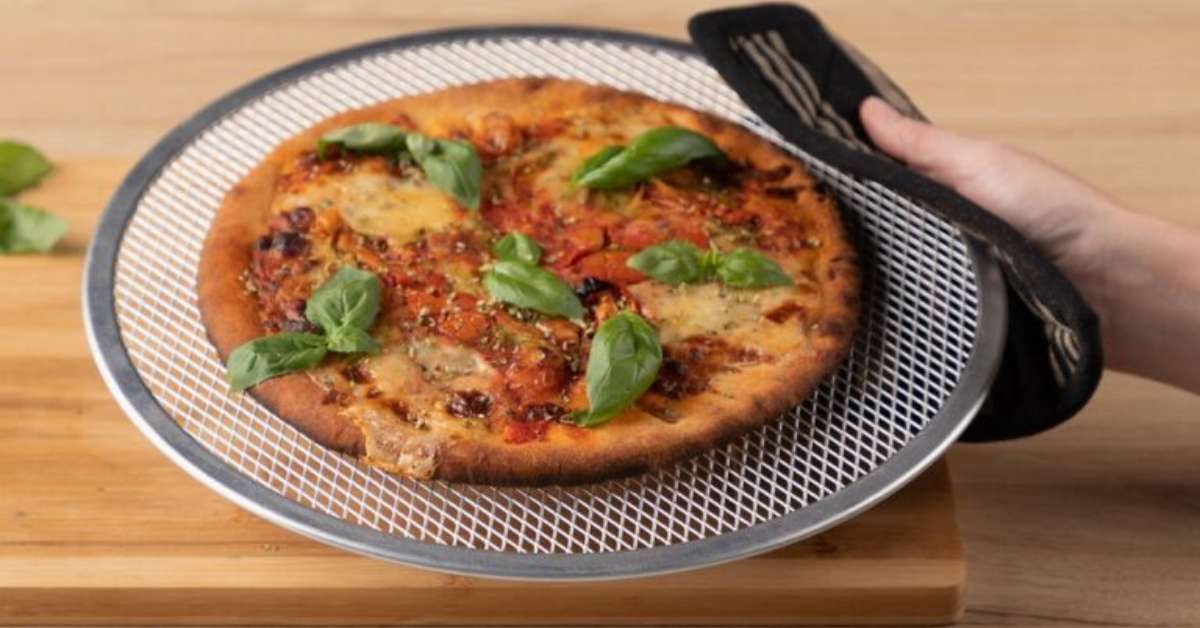When it comes to caring for cast iron cookware, there are plenty of tips and tricks out there. One question often arises is, Can You Use Brillo on Cast Iron? If you’re an avid cook or someone who loves their cast iron skillet, it’s essential to understand the do’s and don’ts of maintaining this unique kitchen tool.
This article will explore using Brillo on cast iron and provide a comprehensive explanation. By the end, you’ll clearly understand how to care for your cast iron and keep it in great shape for years. So let’s dive in and explore the world of cast iron care together.
Table of Contents
ToggleWhat is Brillo and How Does it Work
Brillo is a popular household cleaning product that has been around for decades. It is a scouring pad known for its abrasive properties, effectively removing tough stains and grime from various surfaces. However, when it comes to using Brillo on cast iron, there are a few things you need to consider.
Cast iron is a delicate material that requires special care to maintain its seasoning and prevent rusting. Brillo pads, with their abrasive texture, can damage the seasoned layer of cast iron, which is crucial for its non-stick properties. Scrubbing your cast iron skillet or pan with Brillo can strip away this protective layer, leaving your cookware vulnerable to rust and diminishing its overall performance.
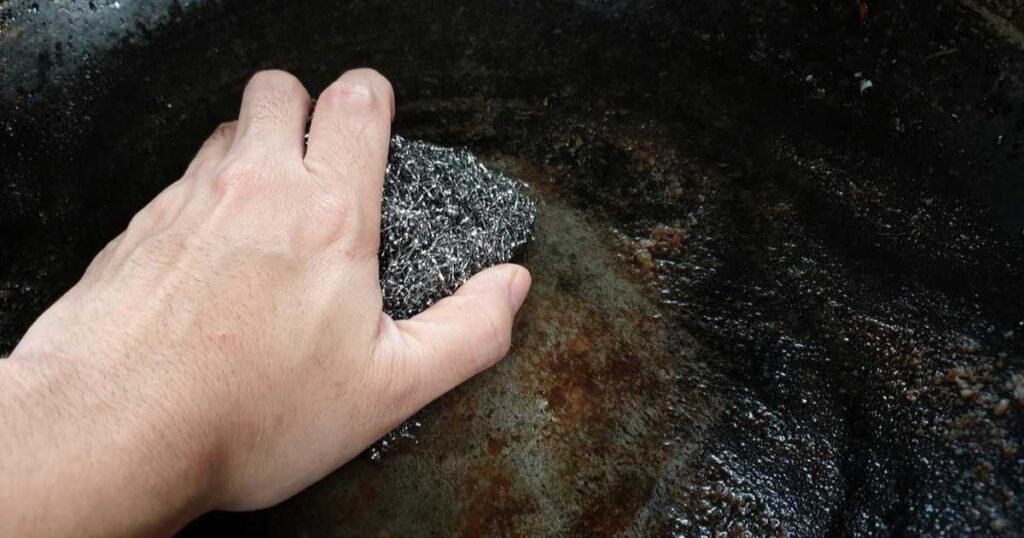
To understand how Brillo works, it’s essential to know that it combines soap and steel wool. The soap helps to break down grease and grime, while the steel wool provides the abrasive action to scrub away stains. While this combination is effective for many cleaning purposes, it can be too harsh for cast iron.
It’s important to note that the use of Brillo on cast iron is a controversial topic among cast iron enthusiasts and experts. You can use Brillo sparingly without causing significant damage with proper care and seasoning. However, the consensus is to avoid using Brillo on cast iron altogether to preserve its seasoning and ensure its longevity.
Can You Use Brillo on Cast Iron
Whether you can use Brillo on cast iron is common among cooking enthusiasts and those who cherish their cast iron cookware. The answer to this question depends on who you ask and their personal experiences using Brillo on cast iron.
As mentioned, cast iron requires special care to maintain its seasoning and prevent rust. Brillo pads, known for their abrasive nature, can damage the seasoned layer of cast iron, which is vital for its non-stick properties. While some individuals claim that using Brillo sparingly on well-seasoned cast iron has not caused significant harm, it’s generally recommended to avoid using Brillo on cast iron altogether.
Using Brillo on cast iron runs the risk of stripping away the seasoned layer, leaving your cookware vulnerable to rust and diminished performance. Instead, it’s advisable to opt for gentler cleaning methods that preserve the integrity of your cast iron while effectively removing any residue or buildup.
The Pros and Cons of Using Brillo on Cast Iron
Using Brillo on cast iron comes with both pros and cons. Let’s take a closer look at the advantages and disadvantages of using Brillo as a cleaning method for your cast iron cookware:
Pros:
- Effective Cleaning: Brillo pads are known for their powerful cleaning abilities. They can effectively remove stubborn stains, food residue, and built-up grime from the surface of your cast iron.
- Time-saving: With its abrasive nature, Brillo can provide quick results when cleaning your cast iron. It requires less effort than other cleaning methods, making it a convenient option for those needing more time.
Cons:
- Damaging the Seasoning: The primary concern with using Brillo on cast iron is that it can damage the seasoning. The abrasive action of the steel wool can strip away the seasoned layer, which is crucial for the non-stick properties of cast iron. This can lead to diminished performance and an increased risk of rust.
- Scratching the Surface: Cast iron is susceptible to scratches, and Brillo pads, with their abrasive texture, can leave marks on the surface of your cookware. These scratches can create rough areas where food can stick, compromising the non-stick properties of your cast iron.
- Chemical Reactions: Brillo contains soap, and while the risk is minimal, there is a possibility of soap reacting with the iron in cast iron, resulting in an off-flavor or discoloration of your food.
Considering these factors, avoiding using Brillo on cast iron is generally recommended. Instead, opt for gentler cleaning methods that preserve the seasoning and integrity of your cookware.
How to Use Brillo on Cast Iron Safely
While it is generally advised to avoid using Brillo on cast iron if you still choose to use it, here are some guidelines to ensure you do so safely:
Limit Usage: Use Brillo sparingly and only when necessary. Regular use of Brillo on cast iron can gradually wear down the seasoning and increase the risk of damage.
Gentle Scrubbing: When using Brillo on cast iron, be gentle with your scrubbing motion. Avoid applying excessive pressure to prevent scratching the surface. A light touch is sufficient to remove minor stains and residue.
Hot Water and Soap: Wash your cast iron cookware with hot water and mild dish soap before using Brillo. This helps to loosen any debris and makes the cleaning process more manageable. Rinse thoroughly to remove all soap residue.
Targeted Cleaning: Focus on specific areas that require extra attention rather than scrubbing the entire surface. This way, you minimize the risk of over-cleaning and damaging the seasoning.
Rinse and Dry Thoroughly: After using Brillo, rinse your cast iron thoroughly to remove any residue. It is crucial to dry it thoroughly to prevent moisture from causing rust. You can towel dry it or place it over low heat on the stovetop to evaporate any remaining water.
Re-season if Necessary: If you notice that the seasoning of your cast iron has been compromised after using Brillo, it’s essential to re-season it. Apply a thin layer of oil and bake it in the oven according to the manufacturer’s instructions to restore the protective coating.
Remember, even when following these safety precautions, using Brillo on cast iron still risks your cookware’s seasoning and overall performance. Exploring alternative cleaning methods that are gentler and better suited for cast iron care is advisable.
Alternative Methods for Cleaning Cast Iron
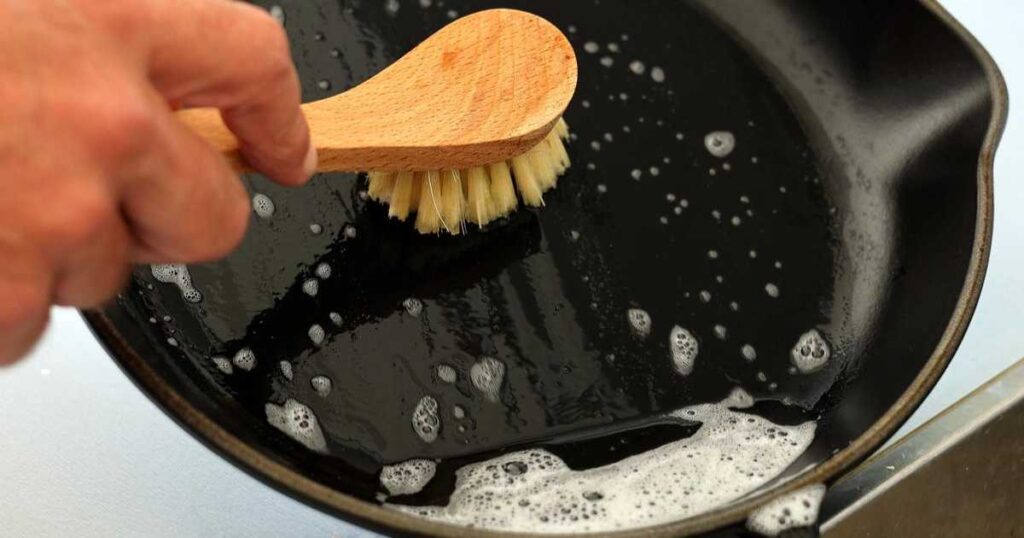
If you’re looking for safer and more effective methods to clean your cast iron cookware, here are some alternative approaches that preserve the seasoning and integrity of your cast iron:
Hot Water and Brush: Rinse your cast iron with hot water after each use. Use a soft-bristle brush or non-abrasive sponge to scrub away any food residue gently. Avoid harsh soaps or detergents, as they strip the seasoning away.
Salt Scrub: For stubborn stuck-on food, create a salt scrub by sprinkling coarse salt onto the surface of your cast iron. Use a damp cloth or paper towel to scrub the salt in a circular motion. The salt acts as a gentle abrasive, aiding in removing residue.
Baking Soda Paste: Another effective cleaning method involves making a paste using baking soda and water. Apply the paste to the surface of your cast iron and use a cloth or sponge to scrub away stains. Baking soda is a mild abrasive that helps to lift off grime without damaging the seasoning.
Boiling Water: Consider boiling water in your cast iron for tough-to-remove residue. This method helps to loosen stubborn food particles, making them easier to remove. After cooking, brush or sponge scrub the surface and rinse thoroughly and gently.
Chainmail Scrubber: A chainmail scrubber is a metal mesh tool designed to clean cast iron. It provides gentle yet effective scrubbing without scratching the surface. Use the chainmail scrubber with hot water to remove any food residue.
Oil and Paper Towel: To maintain the seasoning and prevent rust, keeping your cast iron adequately oiled is essential. After cleaning, apply a thin layer of oil (such as vegetable or flaxseed oil) to the entire surface using a paper towel. This helps to protect the cast iron and maintain its non-stick properties.
Using these alternative cleaning methods, you can keep your cast iron cookware clean and well-maintained without damaging the seasoning. Always dry your cast iron thoroughly after cleaning to prevent rust formation. With proper care, your cast iron will continue to serve you well for many years.
Maintaining Your Cast Iron Cookware
Proper maintenance is crucial for keeping your cast iron cookware in optimal condition. Here are some essential tips to help you maintain your cast iron and extend its lifespan:
Seasoning:
Seasoning is a vital step in cast iron care. Regularly apply a thin layer of oil to the entire surface of your cast iron and bake it in the oven according to the manufacturer’s instructions. This process creates a protective layer that enhances the non-stick properties and prevents rust.
Avoid Soaking:
Never soak your cast iron in water for an extended period. Excessive moisture can cause rusting. Instead, wash it promptly with hot water and a brush or sponge. If there are stubborn residues, use alternative cleaning methods like salt scrub or baking soda paste.
Gentle Cleaning:
When cleaning your cast iron, be gentle. Avoid using harsh abrasives or scouring pads that can damage the seasoning. Stick to soft brushes, non-abrasive sponges, or specialized cast iron cleaning tools like chainmail scrubbers.
Dry Thoroughly:
After washing, thoroughly dry your cast iron cookware to prevent moisture from causing rust. Use a towel to remove excess water, then place it on the stovetop over low heat to evaporate any remaining moisture. Once dry, apply a thin layer of oil to the surface.
Store Properly:
Store your cast iron cookware in a dry place to prevent humidity and moisture from affecting it. Place a paper towel or cloth between stacked pans to protect the seasoning, or hang them on a pot rack.
Regular Use:
Regularly using your cast iron helps maintain its seasoning. The natural oils from cooking help reinforce the non-stick properties. If you have cast iron that you don’t use frequently, consider using it for baking or stovetop seasoning periodically.
Re-Season as Needed:
Over time, the seasoning on your cast iron may wear off or become uneven. If you notice food sticking more often or the surface appearing dull, it’s time to re-season.
Remove any rust, apply a fresh layer of oil, and bake it to restore the protective coating.
Following these maintenance practices ensures that your cast iron cookware remains in excellent condition for years. With each use, your cast iron will continue to develop a beautiful patina and become a reliable tool in your kitchen.
Frequently Asked Questions
Is it OK to use steel wool on cast iron?
Using steel wool on cast iron is generally not recommended. Steel wool is highly abrasive and can strip away the seasoning, leaving your cast iron susceptible to rust. It is best to opt for gentler cleaning methods to preserve the integrity of your cookware.
What kind of scrubber can I use on cast iron?
For cleaning cast iron, it is recommended to use soft-bristle brushes, non-abrasive sponges, or specialized cast iron cleaning tools like chainmail scrubbers. These options provide effective cleaning without scratching the surface or damaging the seasoning.
Can you use a metal scrubber on cast iron?
While metal scrubbers like steel wool are not ideal for cast iron due to their abrasive nature, specific metal scrubbers designed explicitly for cast iron, such as chainmail scrubbers, can be used. These tools have a smoother surface and provide gentle yet effective cleaning without causing damage.
Is it OK to use a scouring pad on cast iron?
A traditional scouring pad, especially those with abrasive surfaces, is not recommended for cast iron. They can scratch the surface and remove the seasoning. Opt for gentler cleaning methods like salt scrub, baking soda paste, or specialized cast iron cleaning tools.
What is the secret to cleaning cast iron?
The secret to cleaning cast iron is gentle cleaning methods that do not compromise the seasoning. Avoid harsh abrasives, excessive soaking, and harsh detergents. Instead, opt for hot water, soft scrubbing tools, and alternative cleaning agents like salt or baking soda. Proper drying and regular maintenance, such as seasoning, are also crucial for keeping your cast iron clean and well-maintained.
Conclusion
Cast iron cookware is a beloved and durable choice for many cooking enthusiasts. While the use of Brillo on cast iron is a topic of debate, it is generally advised to avoid it due to its abrasive nature and potential to damage the seasoning and surface of the cookware.
Instead, use alternative cleaning methods like hot water and gentle scrubbing with non-abrasive tools, salt scrub, baking soda paste, or specialized cast iron cleaning tools. Proper maintenance, including seasoning and thorough drying, is essential for keeping your cast iron in optimal condition. By following these practices, you can ensure the longevity and performance of your cast iron cookware, allowing you to enjoy its benefits for years to come.

